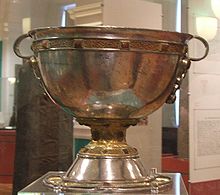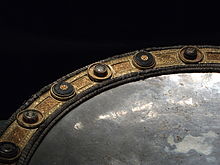- Derrynaflan Chalice
-
The Derrynaflan Chalice is an 8th- or 9th-century chalice, that was found as part of the Derrynaflan Hoard of five liturgical vessels. The discovery was made on 17 February 1980 near Killenaule, South Tipperary in Ireland. According to art historian Michael Ryan the hoard "represents the most complex and sumptuous expression of the ecclesiastical art-style of early-medieval Ireland as we know it in its eighth- and ninth-century maturity."[1] The area known as Derrynaflan is an island of pastureland surrounded by bogland, which was the site of an early Irish abbey. The chalice was found with a composite silver paten, a hoop that may have been a stand for the paten, a liturgical strainer and a bronze basin inverted over the other objects.[2] The group is among the most important surviving examples of Insular metalwork. It was donated to the Irish State and the items are now on display in the National Museum of Ireland.[3]
The hoard was probably secreted during the turbulent 10th to 12th centuries, when Viking raids and dynastic turmoil created many occasions when valuables were hidden. The early and later 10th century is marked by a particular concentration of hoarding in Ireland.[4]
Contents
Discovery
Derrynaflan is a small island of dry land situated in a surrounding area of peat bogs, in the townland of Lurgoe, Co. Tipperary, northest of Cashel. The monastery was an important foundation in the period preceding the Viking raids; the present modest ruins of a small Cistercian nave-and-chancel abbey church there, however, date from a later period.
The Derrynaflan Hoard was discovered in February 1980 by Michael Webb from Clonmel and his son, also Michael, while they were exploring the ancient monastic site of Derrynaflan with a metal detector. They had not sought permission from the owners of the land beforehand. The site was a National Monument, and digging on it was an offence. The discovery was initially kept secret for three weeks.[5]
The behaviour of the Webbs, and nearly seven years of litigation, culminating in the Supreme Court action where they unsuccessfully sought over £5,000,000 for the find, led to the replacement of Irish laws of treasure trove by the law in the National Monuments (Amendment) Act, 1994, with a new Section 2 being included in the legislation.
The Ardagh Chalice dates from around the same period, perhaps a century earlier, of the Derrynaflan Hoard and was found close by in neighboring County Limerick. At the time, the ruling dynasty in Tipperary and most of Munster were the Eóganachta, while their longtime allies and possible cousins the Uí Fidgenti ruled in the Limerick area. Feidlimid mac Cremthanin, king-bishop of Cashel, who became King of Munster in 821 and died in 847, was a patron of the monastic foundation at Derrynaflan and has been suggested as a possible patron of the chalice.[6]
As a masterpiece of Insular art, the Derrynaflan chalice was included in the exhibition "The Work of Angels: Masterpieces of Celtic Metalwork, 6th-9th Centuries AD" (London, 1989, included in the catalogue).
References & footnotes
- ^ Ryan 1997:997.
- ^ Michael Ryan, "The Derrynaflan Hoard and Early Irish Art" Speculum 72.4 (October 1997:995-1017) p. 997, with wide-ranging notes.
- ^ "Museum News – Press Releases (26 July 2006) - Ancient Book of Psalms Discovered". National Museum of Ireland Website. Archived from the original on 2008-01-28. http://web.archive.org/web/20080128000927/http://www.museum.ie/news/details_news.asp?sPressType=1&newsid=230. Retrieved 2008-05-16.
- ^ Ryan 1997:998.
- ^ "Our Great Discoveries". Irish Independent. 29 July 2006. http://www.independent.ie/opinion/analysis/our-great-discoveries-90190.html. Retrieved 2008-05-16.
- ^ Ryan, with reservations, 1997:997: "This sort of particularism is dangerous as hypotheses of this nature tend to be elevated into 'facts'".
See also
Further reading
- Byrne, Francis J., Irish Kings and High-Kings. Four Courts Press. 2nd edition, 2001.
- Duffy, Seán (ed.), Medieval Ireland: An Encyclopedia. Routledge. 2005.
External links
- The Derrynaflan Chalice National Museum of Ireland
- The Derrynaflan Paten National Museum of Ireland
- Derrynaflan Chalice
Categories:- Celtic art
- Archaeology of Ireland
- Culture in South Tipperary
- Treasure troves in the Republic of Ireland
- Religion in South Tipperary
- Silver objects
- Chalices
- Treasure troves of Medieval Europe
- Collection of the National Museum of Ireland
- Metal detecting finds in Ireland
Wikimedia Foundation. 2010.




